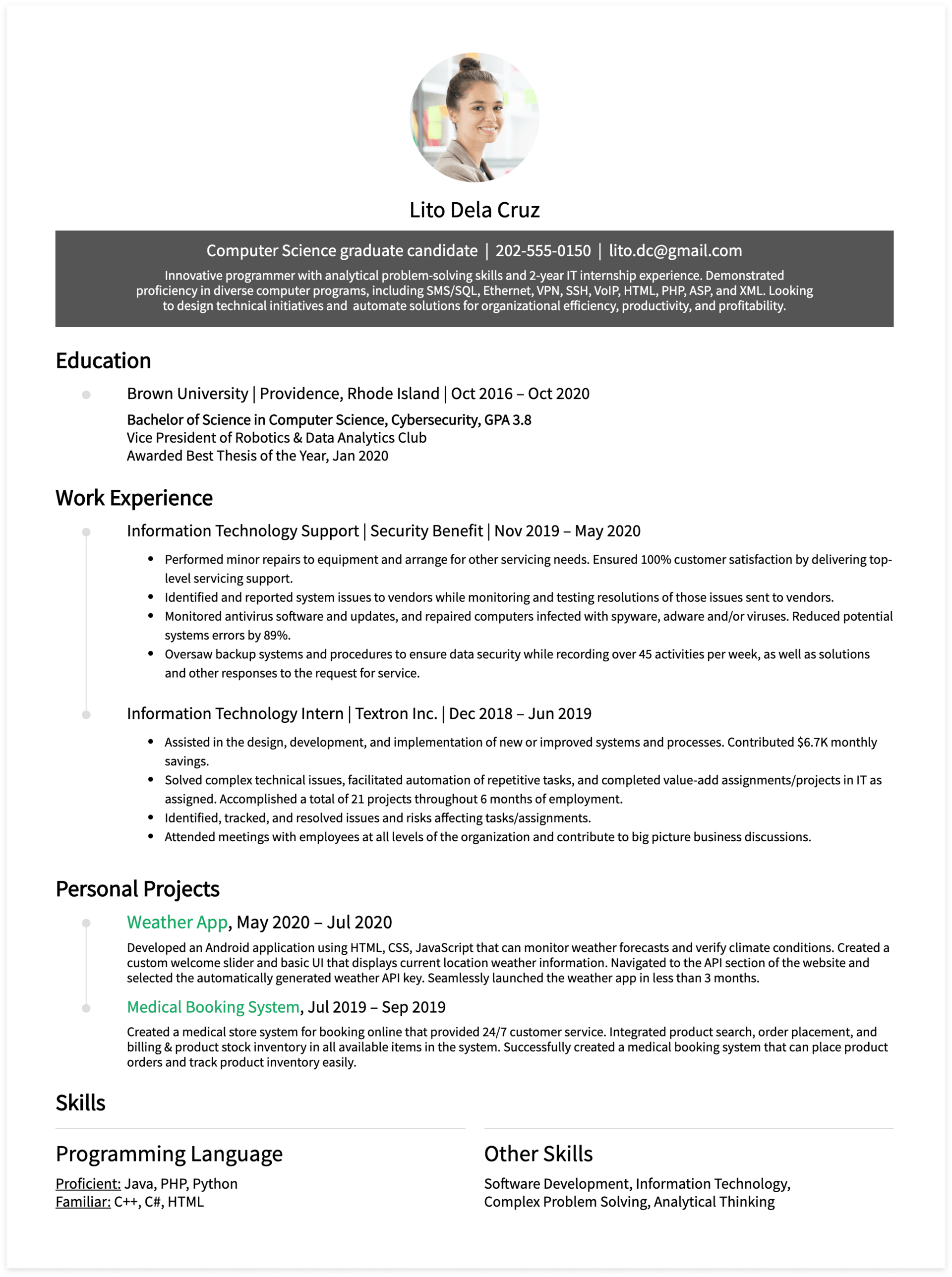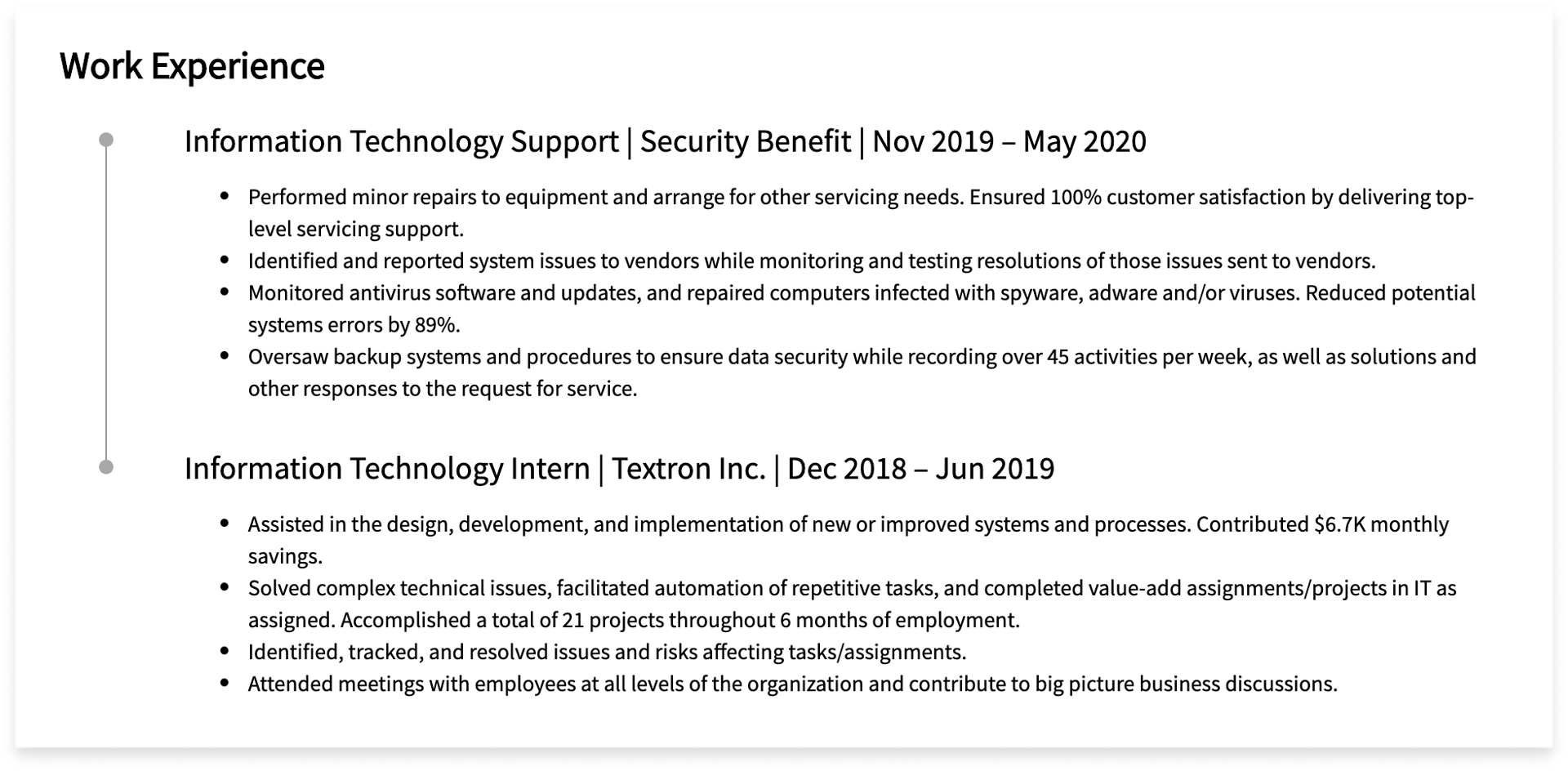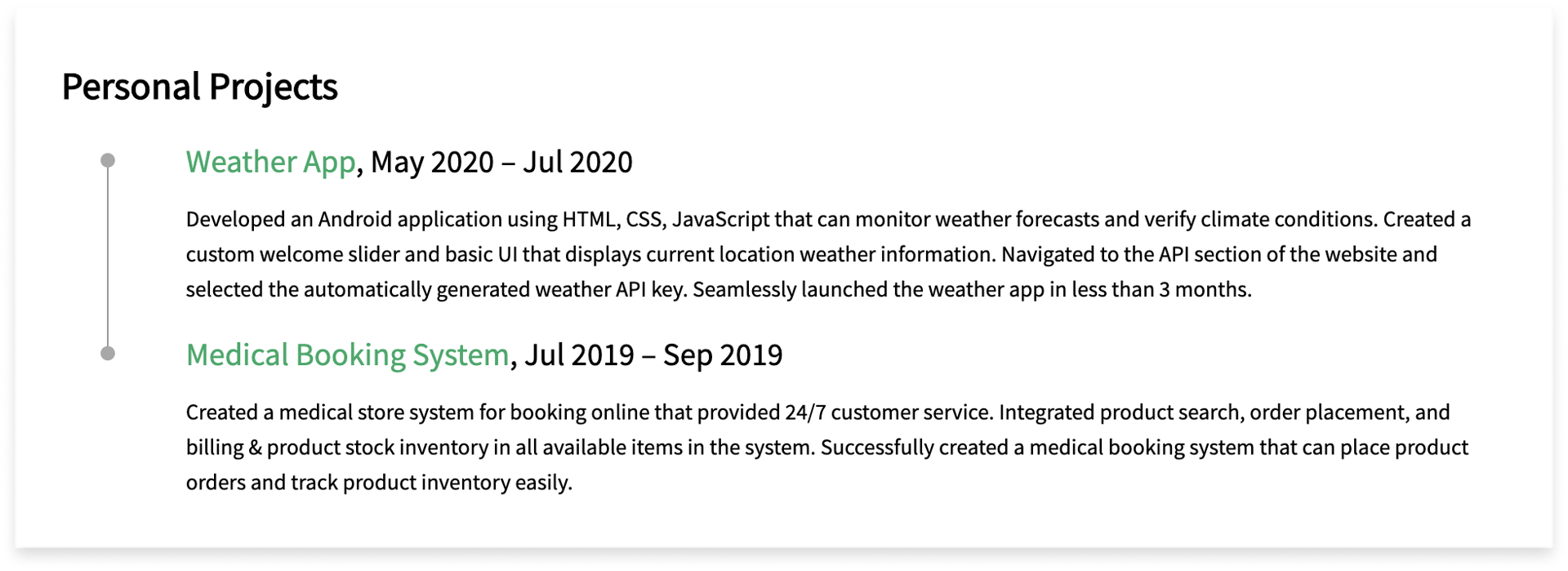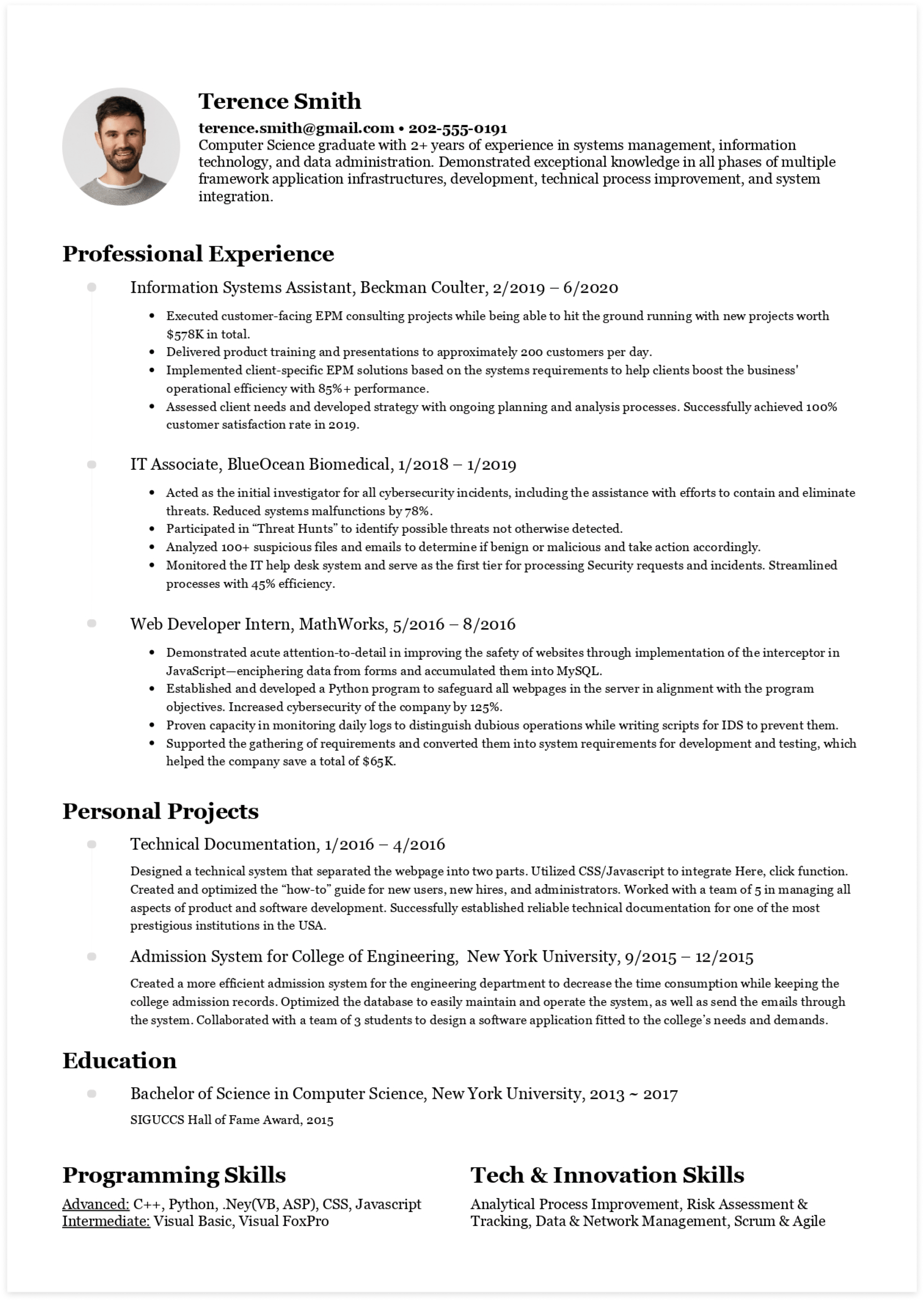Computer Science: Resume Examples, Formats & Tips
Computer science is one of the most in-demand majors in the job market. Jobs for computer scientists are projected to grow by 19% from 2016 through 2026, which is much faster than average, according to the Bureau of Labor Statistics.
Good job for having that advantage!
On the other hand, however, the number of computer science graduates are also rising at an alarming speed, which means: competition is on its way.
How to stand out from the piles of computer science resumes and win that job interview?
Whether you are a CS student looking for internships or a fresher taking your first career step, here are some key tips for a job-winning resume.
Overview
What should be on a computer science resume?
How to choose the right resume format?
Computer science resume examples & templates (Downloadable!)
What should be on a computer science resume?

1. Contact information
For the resume header, include your full name and key contact information, including email address and phone number. You want employers to know where to find you and hire you.
It is also a good idea to add your LinkedIn profile and personal website. Employers can get to know you even more with information beyond the one-page resume.
Full mailing address is not recommended. A full address is often considered too private for a resume, not to mention that employers nowadays rarely communicate via mail.
2. Resume objective / career objective

A resume objective, also called a career objective, is a short paragraph right below the resume header that outlines your skills and career goals. The purpose is to let employers grasp who you are in 7 seconds.
If you are an experienced CS professional, you might want to use a resume summary instead, which highlights your best professional experience and eliminates the career goals.
Given that it should be as brief as possible, include only your top achievements and qualifications. Keep it within 4 sentences!
Sample structure of a resume objective
Title + Core skills/knowledge + Top achievement + Career goals
If you’re a student, feel free to use “Senior student majoring in Computer Science” or “CS graduate from XXX University” as your title, and look for projects or awards to count as a top achievement.
As for core skills, highlight your field of expertise. Computer science is a wide field; are you skilled in software, web, network or data? Which programming languages are you proficient in? You can also add some relevant soft skills such as analytical thinking, flexibility and teamwork skills.
Remember to tailor your resume objective for each different position. Your core skills and top achievements won’t matter if they have nothing to do with the job. Speak to the company missions and the job description, and make sure you are as specific as possible.
How about career goals? Avoid generic descriptions such as “Eager to become a professional app developer.” Instead, do some research on the company values and speak to them.
For example, if they value teamwork, write something like “Looking to contribute my programming skills in a fast-growing, passionate team of skilled developers.” Or, if they are results-driven, write “Passionate about increasing work efficiency and profitability with solid data analysis skills.”
Finally, try to write your resume objective AFTER you’ve finished the rest of your resume. You can find your top strengths only after you scroll through the full page of experience.
3. Skills

Employers hire you because of your skills. Take the chance to highlight your top skills in this section, but make sure you’re ready to prove them with your past experience or projects, and that they are relevant to the position.
Resume skills for computer scientists often include 3 parts: Programming languages, hard skills and soft skills. It's recommended to include skills in all 3 aspects.
Common programming languages:
- Python
- C++
- C#
- Java
- SQL
- Javascript
- PHP
- HTML5
- Ruby/Rails
- ReactJS
Common hard skills:
- Data Structures
- Web Development
- Machine Learning
- Information Systems Management
- App Development
- Data Analysis
Common soft skills:
- Critical Thinking
- Leadership
- Collaboration
- Attention to Detail
- Problem Solving
- Creativity
4. Professional experience

Here comes the most crucial section where you show off your experiences.
Start with your most recent experience and list your title, company name, and employed date.
How about the description? Many people don’t make good use of those descriptions.
You should.
First, look at the job description and requirements. Have you done similar work? Those work should be clearly noted and placed within the top bullet points. In addition, use the exact keywords from the job description if they fit your experience.
Next, use the CAR model to write descriptions.
CAR (Challenge, Action, Result) model
Think of your past work experiences as multiple challenges, and your job duties as actions you took to solve the challenge. Then, describe the results preferably in metrics and numbers to show that you successfully solved the challenge.
Remember: employers want to know how you can help the company. Make sure you highlight results such as “reduced crash rate by 70%”.
Do you have internship, freelancer or volunteer experiences that are also relevant to the job? Treat them as actual work experience.
Further reading: How to write an internship resume? Pro Tips for Students
5. Education

Education might be a short section if you graduated more than 5 years ago. Simply list your school, degree and date of graduation. Include only your bachelor, master and doctoral degrees - high school degrees don’t mean much in the computer science field.
If you are still a student or you graduated less than 3 years ago, make good use of the education section to share a little more about yourself.
Details for Resume Education:
- Relevant coursework
- Academic performance or GPA
- Awards or honors
- Leadership roles in student organizations
- Extracurricular activities
Why add those details? Even if they look irrelevant to a computer science position, they tell something about your soft skills and personality.
For example, if you acted as a president of a student club, you likely have leadership and teamwork skills. If you maintained a high GPA, perhaps you know how to take responsibility and manage your time better than others.
6. Other

Computer science professionals often have personal projects. Have you created a webpage or an app? Polish some of your best works and share them in a bonus section.
Have you earned certifications that prove your programming skills? Consider adding a certificates section to show off your achievements.
Think about your strengths and past works that you are proud of. Are they visible within your resume? If something is missing, feel free to create a bonus section to showcase your skills - don’t limit yourself to the traditional resume components. Just remember to keep it short and sweet!
Further reading: College Students: Resume Examples, Formats & Tips
How to choose the right resume format?
1. Resume format
You might heard of the 3 common resume formats:
- Chronological resume (or reverse-chronological resume): As the most popular resume format, a chronological resume shows your most recent experience first, and then backward through time.
- Functional resume: Instead of listing in a chronological order, a functional resume categorizes your experiences in terms of professional skills.
- Hybrid resume: Integrating the elements of the two formats above, a hybrid resume contains an individual section for professional skills but still lists experiences in a chronological order.
It’s important to keep the purposes of these formats in mind. A chronological resume aims to place your best experience upfront, while a functional resume emphasizes your skills regardless of your title or employed time.
Simply put, a chronological resume is the most straightforward choice, while a functional resume is best for those with large time gaps between jobs or with significant career changes.
Which one should you pick? If you have both a professional skills section and a work history section, it is more or less a hybrid resume. Simply place extra emphasis on the section that best showcases your strengths.
Key Takeaway
No matter which format, place the most recent or most important items first.
2. Resume layout & design
Given that you are a computer scientist, not a designer, it’s smart to keep your resume design simple.
But simple doesn’t mean dull and boring. You can still make extra effort to make it welcoming, reader-friendly, and personalized. Why bother? Remember that recruiters only spend 7 seconds before deciding whether a resume is a go or a no-go. A nice and clean design definitely makes a good impression.
Try using a customizable resume builder to save you some formatting time.
Resume builders such as CakeResume help you easily drag and drop texts and images with clean formatting and decent white space.
As for resume layout, it might be tempting to use a double-column layout. True, double-columns can often store more information without sacrificing white space, but beware of distortions with ATS.
Applicant Tracking Systems (ATS)
Recruiters from large companies often use ATS, an AI software, to help them organize and manage hundreds of resumes and job applications. ATS can search for keywords and even rank resumes by comparing content between resumes and job descriptions.
Since ATS are robots, sometimes they can’t read columns. If you are applying for a position that might receive hundreds of resumes, perhaps you’d want to stick to a single-column layout. If you’re sure a human will read your resume, feel free to use columns to better organize your resume.
3. Resume font
Again, resumes should be reader-friendly. And fonts matter a lot when it comes to reading.
The safest choices are the most common fonts such as Helvetica, Calibri, Arial, and Times New Roman.
If you want a more modern look, pick sans serif fonts such as Open Sans or Roboto. If you want to look classic and sophisticated, try serif fonts such as Georgia or Cambria.
Either way, make sure you stay away from fonts that are too bold, too playful and too stylish such as Comic Sans, Scripts, and Impact. They are more difficult to read, which shows that you are unprofessional.
Ready to build your resume? Use our resume builder to quickly and easily build a stunning resume for free!
Computer science resume examples & templates (Downloadable!)

Like the design? Use CakeResume's free resume builder to easily make yourself a stunning resume.
Check out more resume examples on CakeResume!
4 bonus tips for computer science students
Have limited work experience? No worries. Everyone starts from zero. Here are a few tips to help you get a head start.
1. Treat your unpaid experiences as professional ones. Just because you weren’t paid does not mean your work has no value. As long as your work is relevant to computer science, whether it’s volunteering as a code mentor or helping a professor setup a website, treat them as internships or freelance works.
2. Have little work experience? Gather your class projects or personal side projects, and make a portfolio website to demonstrate your skills. For CS majors, skills and projects sometimes matter more than actual work experience.
3. Not sure where to find opportunities? Maybe you need to start networking. Recruiters tend to rely on referrals when looking for candidates since they save a lot of time and effort.
Don't know how to network? Here are some networking tips for college students:
Why Networking Helps You Land a Job: 6 Easy Ways for College Students
4. Don’t be afraid to ask for advice. Take your resume to your parents, friends, professors, or even career coaches to ask for advice. Not only can they proofread your resume and spot typos, but they can also point out some of the strengths you have that might be missing on your resume.
Ready to build your resume? Use our resume builder to quickly and easily build a stunning resume for free!
More Career and Recruitment Resources

Storytelling for social change, inclusive UX designs and gender equity light up my heart. Find me on LinkedIn.






